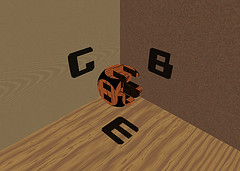Gödel, Escher, Bach: an Eternal Golden Braid
Note: this is a homework for my English class.
I really think everyone should read Gödel, Escher, Bach: an Eternal Golden Braid by Douglas Hofstadter. He is a University professor, whose interests range from philosophy to mathematical logic and artificial intelligence, from art to consciousness and beauty. Moreover, he deeply investigates the connections between these areas of human knowledge.
The book I am suggesting is the amazing result of these investigations. Hofstadter managed to write a treatise on the subjects he is an expert in, but also a work of art in the most strict sense. The focus of the essay is on the work of the three people named in the title: Gödel, a logician, Escher, an illustrator, and Bach, a composer; in particular, Hofstadter found similarities in their opuses, and exploited them to convey his expertise in logic, philosophy and intelligence. The main concepts the book focuses on are “recursion” and “self-reference”. Bach’s canons, Gödel’s proof of the incompleteness theorem, Escher drawings of an art gallery with that particular drawing exposed, all strongly hint to these two ideas, and they are throughly analyzed in the book.
Every chapter of the essay focuses on particular examples of the two concepts, and is preceded by a dialog between characters inspired by Lewis Carroll’s “What the Tortoise said to Achille”. In these dialogs Hofstadter gave his best. They are a never ending collection of puns, puzzles, word plays, self-reference to themselves, to the book, to the following chapter, to the work of Gödel, Escher, and Bach, and, I suspect, to the Universe as a whole. Nonetheless, they are not “beautiful and useless”, but the language and ideas they introduce are used throughout the following chapters to explain difficult concepts. In order to give a visual interpretation of what I am talking about, consider the cover of the book.
Then, expressed visually, Hofstadter’s book is like seeing an “H” when lighting the cube from a corner: it shines a light on the interconnected works of Gödel, Escher, and Bach, but is also a work of art of in itself, with the same dignity and even more deep connection to the others.
It would seem that a book so precisely written would have to be very static: changing a single word could ruin a self-reference, a word pun, or a sentence with a prescribed structure. For this reason, it is striking that the book has been translated in many different languages, and still retains a lot of the original version. Even more: sometimes additional puns have been made possible by the new language, and exploited by the translators. Of course a book like this cannot be translated without a lot of help from the original author. Indeed, Hofstadter did a tremendous amount of work to annotate his book line by line to sort out for the translators every single hidden structure.
